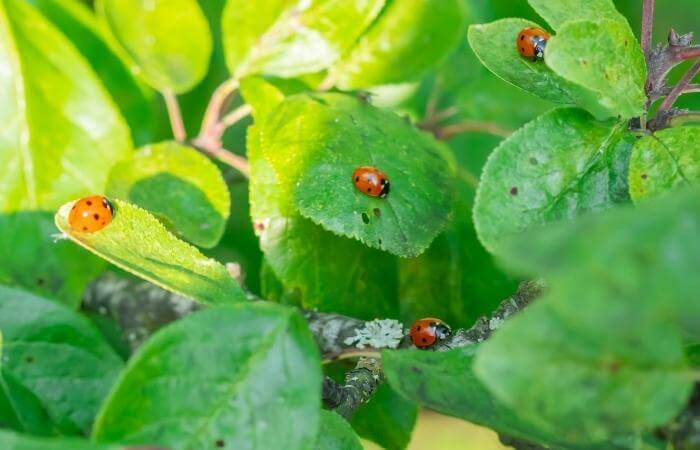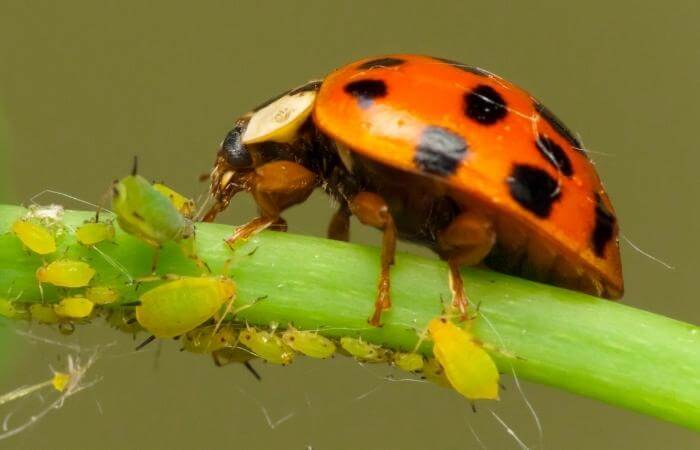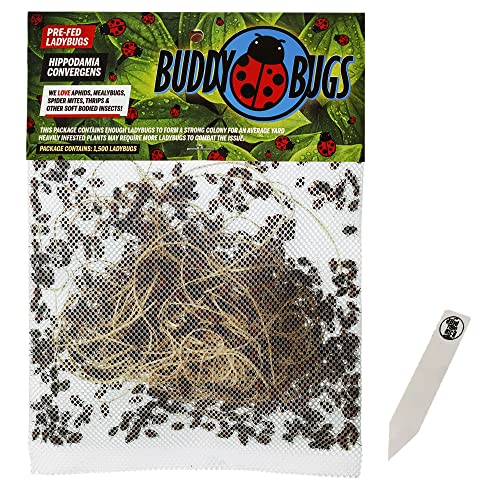Are you a gardener looking for alternatives to chemical pesticides? If so, you’ll want to consider buying ladybugs for your garden.
Ladybugs are highly skilled at killing common garden pests, so your vegetables, flowers, and other plants grow happy and healthy.

This guide explains what you must know about using ladybugs in your garden, what pests they eat, and what keeps them in your yard. I also share which ladybug species are best for gardening, buying tips on quantity, and finding reputable ladybug sellers.
Ladybugs are a natural way to keep plants healthier, so keep reading and learn more!
Are Ladybugs Good For Your Garden?
Ladybugs are excellent for your garden because they kill and eat many pests that damage your plants. However, there are more pros and some cons to introducing extra ladybugs to your garden, which include:
Ladybug Pros:
- Ladybugs and their larvae eat massive quantities of common garden pests
- Ladybugs also help cross-pollinate flowers, vegetables, and plants
- Ladybugs do the work for you, so you can avoid spraying your plants with pesticides
- Ladybugs are a natural way to control pests without harming the environment
Ladybug Cons:
- Ladybugs will fly away if there isn’t enough food for them in your garden
- Ladybugs bought from sellers in another region may spread disease
- Some ladybug species are more suitable for gardens than others
Overall, you can’t go wrong placing ladybugs in your garden.
You can choose to purchase ladybugs in quantity to quickly eradicate an infestation of aphids or other insects destroying your garden, or you can use the methods I explain down below to attract them from the area around your home.
However, it can take a lot of time and work to attract hundreds of ladybugs to your garden naturally, which is why purchasing ladybugs in bulk is more effective.
Are Ladybugs Good For Aphid Control?

Ladybugs are especially good at aphid control. Ladybugs can quickly get an aphid infestation under control because they are voracious eaters, and a big population can clear the pests from your garden in a matter of days.
Ladybug larvae and adults will devour up to 50 aphids daily, as well as mites, beetles, the eggs and larvae of other pests, scale bugs, and even tiny caterpillars.
Aphids are a top garden pest because they harm your plants by sucking sap, introducing viruses, and leaving deposits of honeydew that disfigure flowers and foliage and encourage mold to grow.
With about 400 of the 5,000 species of aphids attracted to traditional garden plants, they will quickly take up residence at your home just about anywhere across the US.
When aphids get into your garden, the biggest issue is how quickly they reproduce. Females will eventually grow wings to find new plants to feed on and lay their eggs.
Females can also reproduce without a male, making them more of a pest than they already are.
Clearing your garden of aphids using ladybugs is efficient and doesn’t require the use of dangerous chemical pesticides.
Do I Need Ladybug Nectar?
Ladybug nectar is a sugary and sticky substance that will attract insects and keep them around when their natural food supply runs low.
Most commercial ladybug nectar products contain a mixture of ingredients that mimic the pollen, sap, and honeydew found in nature that ladybugs need to survive.
The nectar also supports ladybug reproduction, so you can have new generations hatching in your garden and helping to keep your plants healthy.
Providing ladybug nectar is beneficial when ladybugs don’t have aphids or other pests to eat or enough flowers for pollen and nectar. Without it, the ladybugs will fly off to greener pastures if they don’t have food.
You can DIY basic ladybug nectar by stirring sugar and warm water together until it dissolves. Then, transfer the liquid nectar into a spray bottle and mist it here and there over your garden plants, so it pools up in the crevices of the leaves.
Another good way to provide nectar for ladybugs is to grow certain plants that provide nectar-rich flowers, such as:
- Fennel
- Coneflowers
- Coreopsis
- Cosmos
- Butterfly Weed
Please remember that ladybugs cannot mature and lay eggs unless they have pollen and nectar, so using natural plants instead of a homemade spray is better for providing both.
What Ladybugs To Buy?
With over 5,000 species of ladybugs, it may be confusing trying to figure out which ones you should buy for your garden.
Every region has several local species of ladybugs that thrive under the specific environmental conditions and food sources available.
Most sellers of ladybugs do not have “ladybug farms” where they breed the beetle but instead attract and collect ladybugs native to their area and ship them to customers.
So, which ladybugs are best to control garden pests?
The top ladybug species to consider when shopping are:
- Asian Lady Beetle
- High Sierra Ladybug
- Convergent Lady Beetle (Hippodamia Convergens)
- Coccinella Ladybug (Coccinella Septempunctata)
These species are common across the US, so they do well in your garden no matter what company you buy from.
Adult ladybugs have a round or oval dome-shaped body with an orange or red “shell” with black spots. Some ladybugs will have a black shell with red dots.
The number of spots on the shell is a way to identify which ladybug species is in your garden.
Ladybird beetles are another option for your garden. These beetles look just like a traditional red and black ladybug but have a yellow shell and black spots.
Tips For Buying Ladybugs
If you’re planning to buy ladybugs for garden use, it’s best to follow the tips below to ensure you’re getting the suitable species and amount to get the job done.
1. Know What Ladybug Species You’re Buying
If a seller doesn’t indicate which ladybug species they have for sale, it’s wise to bypass them. Instead, look for a retailer that clearly states what type of ladybug they sell and search online for customer reviews to see their reputation for yourself.
You’ll want one of the species that will do well across any US region and not a native species that can’t tolerate being shipped to a different climate.
Also, look for the seller to include instructions for releasing the ladybugs into your garden to reduce stress and help them integrate into their new surroundings.
2. Know How Many Ladybugs To Purchase
Ladybug sellers generally offer quantities to cover specific square footage in your garden, with an approximate number of ladybugs in that batch.
For example, if your garden is about 2,500 square feet, you’ll purchase a 1/2 pint of ladybugs which should hold about 4,500 individual beetles.
Here is a list of other size gardens for easy reference when shopping for ladybugs:
- 750 sq ft = 1,500 ladybugs
- 5,000 sq ft = 9,000 ladybugs or 1 Pint
- 10,000 sq ft = 18,000 ladybugs or 1 Quart
- 1/2 acre = 36,000 ladybugs or 1/2 Gallon
- 1 acre = 72,000 ladybugs or 1 Gallon
3. Try to Buy Ladybugs from a Seller Nearest You
To lower the chance of ladybug death or disease, purchase from a seller as nearest to your location as possible.
Buying from a nearby source will lessen shipping time and not introduce any non-native viruses that your plants can’t tolerate.
How To Add Ladybugs To Your Garden
Once your ladybugs arrive, you need to follow some standard rules to ensure they can transition to your garden without issue.
First, wait until evening to release the ladybugs, as it’ll be cooler, and they’ll be less likely to fly away. Until then, please leave them in a refrigerator until you’re ready to bring them outside.
Before you open the box, water your garden so everything is moist. If you have an obvious pest problem, release the ladybugs at the base of these plants.
If you don’t have sufficient food in your garden for the ladybugs to eat, they’ll want to leave, so spray some ladybug nectar over the foliage before release to entice them to hang around.
Where To Buy Ladybugs
You may be able to find a local seller of ladybugs through garden centers, cooperative extensions, or social media marketplaces. Buying batches of ladybugs collected from your region will increase the odds of survival and reproduction of the species.
You can also go online to buy ladybugs from specialty stores, such as The Hydroponic City Store.
Use the above tips whenever buying from an online seller. Some companies buy mass quantities from overseas and resell them to unsuspecting customers who find many dead on arrival or carrying disease.
In Summary
Ladybugs are the natural solution to control aphid or pest infestations in your garden quickly.
Many expert gardeners make the purchase of ladybugs an annual event because most ladybugs you release will fly away in a few weeks once the pests are gone.
Please don’t be upset when they move on; it’s a good thing and worth the investment to have a beautiful and fruitful garden!











